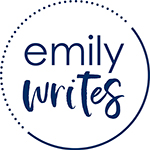Staring at a blank page can be the worst feeling in the world. And writer’s block strikes more than just full-time writers!
Anyone who writes emails, social media posts, or other correspondence on a regular basis knows what it feels like to be at a loss for words. As a small business owner, you wear a lot of hats – and writing is probably one of them, even if it’s not your strongest skill.
I’m not immune to this phenomenon. In fact, I hit writer’s block a couple of times every week! I’ll start working on a project but find myself at a loss for words. Luckily, tools like AI can be very helpful for unblocking my creativity and getting back into the writing flow.
Let’s talk about how generative AI can help you overcome writer’s block, plus four non-AI strategies that will help you the next time you’re feeling stuck!
Tip 1: Use a Generative AI Tool
I first dipped my toes into generative AI by using the free version of ChatGPT and soon committed to a monthly subscription with one of the more advanced programs it powers, called Magai. As a content writer who creates original content for my clients, I use Magai as a tool to enhance my writing, not as a replacement for original content. Nothing gets passed straight to publication without extensive human touch!
Side note: I’m actually an affiliate partner for Magai because I LOVE its interface and ability to save personas, prompts, and brand voices. Visit this link to get a 7-day free trial.
So, how can AI help you overcome writer’s block as an entrepreneur?
- Ask Magai to give you ideas for content: “What are 20 social media post ideas for [your industry]?” or “Tell me 10 concerns or worries [your audience] have regarding [your product or service]” or “Here are the titles of the last 15 blogs I wrote, can you give me ideas for 15 more?”
- Ask Magai to write a first draft: Paste your outline, key points, or scattered notes into a chat and ask Magai to “expand on what I’ve written here” or “turn these notes into a 300-word video script.”
- Ask Magai to write headlines and subject lines: Paste your email or blog into a chat and ask Magai: “Give me 10 snappy subject line ideas for this email” or “Give me 10 eye-catching titles for this blog.” I like to give a word limit also, or AI will get too long-winded. Something like, “Make sure each one is 6-8 words long” will do the trick. You can even specify if you want emojis used!
- Ask Magai to give you an outline: Use AI to outline a longer piece of content, such as an ebook: “I’m writing an ebook about [topic] that will include [number] chapters. Some of my key points include [list]. Write me an outline.”
Tip 2: Copy and Paste
I write a lot of websites and long-form content like blogs. To get myself going, I’ll copy and paste any information that is relevant to the topic at hand.
For example, when I sit down to write a website, I always use a StoryBrand outline in a Google doc that I’ve already created for myself. I go through all of my notes from my interview with the client and organize them into each section of the website. I also paste any relevant information I’ve gathered from their prior website or other content they’ve created (social media, video scripts, etc.) that I want to incorporate.
With all the key facts and information in one place, it becomes much easier to start the project. And let’s face it, just having something on the page is motivating!
An alternative to this method is to print off all the facts and information you need or use multiple computer screens so you have everything at your fingertips.
Tip 3: Outline Key Points
You probably have a bunch of incoherent ideas swirling around your head when you start to write, so just jotting down a couple of key points or a rough outline will help settle your brain and give you a starting point. Then, start expanding on each key point. It doesn’t matter which one you tackle first; you can always rearrange as you go.
For example, when I sit down to write 12 social media posts for a client, I outline what each of the 12 posts will cover with just a few words or phrases. Then, I go back and write the post I’m the most excited about (or maybe it’s the one that’s the easiest to write!) and then tackle each post, one by one. Breaking your writing into smaller, more manageable chunks helps you get over writer’s block.
Tip 4: Start in the Middle
The first few sentences of a project are often the hardest to write! We want to hook our readers right away.
I have a degree in journalism and worked at three newspapers throughout my college years. I have the “lede” structure – “who/what/where/when/why/how” in the first paragraph – burned into my brain. Condensing an entire article into a couple of sentences was always so intimidating to me, so I learned to work backward and start with the less important information and quotes, first, and work up to the lede.
Now, as a content marketer, I’m hyper-aware of the fact that my very first sentence of a social media post or the introductory story in a blog are absolutely critical to hooking the reader. That’s why I often start at the end or somewhere in the middle, making the introduction easier to write once I’m in the flow.
Tip 5: Find Synonyms
If you’re really struggling to get words onto paper, start with something super basic: synonyms.
For example, I recently wrote website content for a fellow solopreneur. I was struggling to get into the flow, so I started looking up synonyms for some of the keywords I knew we were going to be using, such as “connection” and “brand” and “strategy.” I like using the OneLook Thesaurus for this method.
Yup, I just started compiling lists of words. It sounds crazy but it really does work! These individual words sparked ideas for entire sentences and new combinations of concepts, and I was quickly on a roll.
~
Overcoming writer’s block isn’t as simple as waving a magic wand, but I hope one of these methods helps propel you out of your funk. Save this article for the next time you’re stuck, or at the very least, try out those AI prompts!
And if you like content like this, make sure you’re subscribed to my email newsletter. You’ll receive an email every other week with fresh content and entrepreneurial advice.

